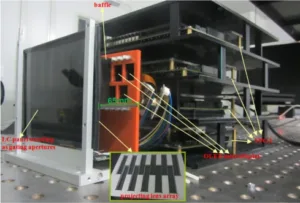Chinese researchers have developed a new display with ‘comfortable’ 3D effects, which is claimed to eliminate the sensation of nausea that some people suffer from when using 3D displays. The technology can be used on slim displays, whose design poses an additional challenge.
Working from Sun Yan-Sen University, the team based their device on a super multi-view system; this also reduces the required number of microdisplays to make the 3D work.
The most substantial cause of 3D-viewing discomfort is known as the vergence-accommodation conflict, said associate professor Lilin Liu. Vergence-accommodation conflict is a mismatch between the point at which the eyes meet on an image and the distance to which they focus, which viewing 3D imagery.
Because of the distance between them, humans see slightly different images with each eye. The distance at which their sight lines cross is known as the vergence distance. Our brain adjusts the focus of the lens in each eye, to make the image appear clearly on the retina; the distance to which the eye is focused is called the accommodation distance. Failure to converge leads to double images, while mis-accommodation leads to blurry images.
While looking at the real world, our vergence and accommodation responses are correlated with each other, and adjust at the same time. This means that the vergence and accommodation distances are almost always the same.
A conventional 3D display tries to mimic natural viewing by creating images with varying binocular distances (simulating vergence changes in the natural landscape). However, the accommodation distance is unchanged, set at the display distance; this leads to the vergence-accommodation conflict. Some views of the displayed spot are also sent only to a single eye, not both, further enhancing the conflict.
To solve the issue, the team projects multiple 2D views to viewpoints with intervals smaller than the pupil diameter of the eye; this enables the sending of at least two different views to a single eye pupil. This makes the eye naturally focus on the displayed images.
The prototype device is built using 11 basic projecting units; each uses an OLED microdisplay, rectangular projecting lens and two vertical baffles. A group of gating apertures (LCD panels) is attached to the lens. Dense viewpoints can be obtained on the screen by gating different gating apertures in sequence, and synchronously refreshing the virtual image of the corresponding microdisplay. Liu said, “Creating a dense arrangement of viewpoints on the display screen is the key to comfortable 3D effect”.
Because the gating apertures are attached to the lens, the prototype structure is thin: around 65mm. Adjustments, said Liu, could make it even thinner.
The work has been published in Optics Express.
Analyst Comment
I wonder whether the vergence-accomodation conflict is really the only reason for the discomfort that some feel. There are many depth cues involved in 3D and there doesn’t seem to be much evidence on the human factors side in this article. The sample of users was just eight, which seems a small number to me. Nevertheless, it’s good to see researchers looking at these issues. (BR)

